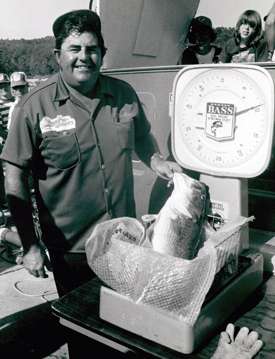
Just as Michael Jordan was a natural at basketball and Babe Ruth was seemingly created to hit a baseball, Billy Westmoreland was born to catch smallmouth bass. In the eyes of many, he was the greatest smallmouth angler who ever lived. He is also almost certainly the only man to catch both largemouth and smallmouth bass that exceeded 10 pounds.
Westmoreland was born in Tennessee on June 30, 1937, just a few years before construction began on the dam that would create Dale Hollow Lake. As a boy, he fished and boated all over the 27,700 acres that formed the legendary trophy smallmouth fishery. His knowledge of the lake’s underwater terrain was unequalled. So, too, was his fishing success there.
He began his professional guiding career on Dale Hollow at the age of 13, often skipping school to take clients out on the water. Initially, Westmoreland took the leftover clients, those who showed up too late to get a more experienced guide. Soon enough, though, those same anglers were requesting the youngster with a penchant for catching lots of smallmouth.
As a youth, Westmoreland’s love of fishing split time with his passion for football. He was a star on his high school team, and the game was his ticket to college at Middle Tennessee State University in Murfreesboro. While there, he injured his knee and began to focus even more of his time on bass fishing.
Westmoreland was known not only for catching smallmouth bass but especially for catching big smallmouth bass. The largest he ever hooked was also the biggest he said he ever saw. On Christmas Day in 1970, Westmoreland tied into a brown bass he estimated at between 12 and 14 pounds — larger than the world record.
“I know how big it was because I had a couple of 7- or 8-pounders in the livewell at the time,” he later said.
He was fishing a Pedigo Spinrite on a cold, windy day when the giant struck. After a long initial run, Westmoreland was starting to gain line on the bass when it surfaced and wallowed on top.
“I can’t describe how I felt except I got very nervous, which I seldom ever do. It was because I really knew what I had. I couldn’t believe how big it was.”
He got the bass to within just a few feet of his boat before she sounded and got 15 or 20 feet down. Then disaster struck. The lure popped out of her mouth.
“Losing that one disturbed me because something I’ve dreamed of all my life was catching the biggest smallmouth anyone had ever caught,” Westmoreland said. “But it bothered me so much and to the point that, over the next 16 to 18 months, lots of times I’d be home watching television at night and I’d start thinking about that fish. Then I’d think that maybe this was the night. The fish might be back on that point. I’d convince myself while I was in the chair watchin’ TV that the fish was on that point waitin’. Out the door I’d go, and I’d hook on to the boat, slap that boat in the water and go fish for a couple of hours.”
Westmoreland was so haunted by the big bass that he’d often chase after her at 3 or 4 in the morning in all sorts of weather. Though he never hooked or saw her again, he caught plenty of other big smallmouth, including one that weighed 10-1.
In the decades after losing that fish of a lifetime, Westmoreland told numerous friends and acquaintances just where he hooked the giant. Unfortunately for them, he told each a different location. It was an example not only of his sense of humor, but also his competitiveness. In the end, he took the location of the giant bass to the grave with him.
Westmoreland came to national attention in the 1970s while competing professionally on the Bassmaster Tournament Trail. In his seven-year career, Westmoreland qualified for six Bassmaster Classics, finished in the top 10 in the 35 professional tournaments he fished and won three national events — the 1974 and 1975 Florida Invitationals (both on the St. Johns River) and the 1977 Arkansas Invitational (on Greers Ferry Reservoir).
In 1973 at the BASS Arkansas Invitational on Beaver Lake, a tornado went through the area, and the boat containing Johnny Morris (founder and owner of Bass Pro Shops) and Robert Craddock filled with water and sank. The cold was numbing and the two anglers realized they could survive but a short time in the water before hypothermia would set in. Their situation was so desperate that they were scratching a message to their loved ones on an old gas can when their prayers were answered. Westmoreland had seen the gas can from the launch area and decided to go pick it up. He was concerned that another boat might not see it and that it might cause an explosion. As Morris described it, Westmoreland’s big hand came out of the sky to save them.
In 1976, Westmoreland and South Carolina outdoor writer Larry Mayer published what stands as the seminal work on smallmouth bass fishing, Billy Westmorland on Smallmouths: Them Ol’ Brown Fish. Three years later they followed it up with Largemouths and Tournaments … Good or Bad?
Westmoreland’s homespun ways and charm shine through in Them Ol’ Brown Fish. In Larry Mayer’s introduction, he noted that the book was “written in the fishing language instead of the English language.”
In addition to the trophies, books and tournament success, Westmoreland owned an interest in Horse Creek Resort on Dale Hollow Lake and designed several successful bass lures. One of the most notable baits he helped to design was the Silver Buddy, a blade bait manufactured by his friend Buddy Banks. Westmoreland called it the greatest lure ever devised for catching smallmouth.
Throughout his tournament career and with both of his books, Westmoreland spelled his surname without the second “e” — Westmorland. It was an affectation that perplexed even those who knew him well. He explained it by saying that the second “e” was difficult to write when signing autographs. For the rest of his life, he was “Westmorland” publicly and “Westmoreland” in all other cases.
In the 1980s, after having retired from professional tournament fishing, Westmoreland went into television with Billy Westmoreland’s Fishing Diary. The theme song for the program, “I Like Catching Smallmouth Best of All,” co-written by Westmoreland, says a lot about his love of the outdoors and smallmouth bass fishing.
Everyone I know loves fishin’, and leavin’ cares behind,
The feelin’ of a big one on the line.
I like freshness of the springtime and colors of the fall,
But I like catchin’ smallmouth best of all.
Sure do like the easy feel of a lazy summer’s day
The sun on my back, wind across my face.
But I start feelin’ warmer come the first snowfall,
Cause I like catchin’ smallmouth best of all.
In his final years, Westmoreland was affectionately known around Dale Hollow as “the Legend of the Lake.” No one did more for the area’s reputation or more to put its smallmouth fishing on the map.
He died on Sept. 29, 2002, following a seizure in his home overlooking his beloved lake. He was 65 years old. His headstone bears his likeness fishing from a bass boat and fighting a big smallmouth. In 2004, he became the first person to be posthumously inducted into the Bass Fishing Hall of Fame.

